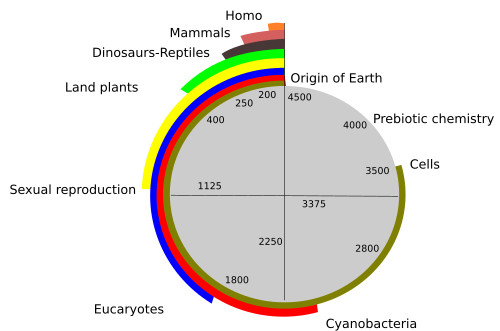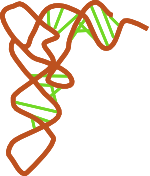The discovery of the origin of life is the discovery of the origin of the cell. It is widely accepted that it was by physicochemical processes. As a physicochemical process, it has consequences in the field of biology. a) We can create life. A cell could be made from scratch by using molecules that exist in current cells and placing them together into a membrane bound compartment. b) Extra-terrestrial life. Physicochemical conditions, similar to those present on Earth during the origin of life, may have occurred elsewhere in the Universe. Extraterrestrial life may have emerged.
1. What is a living organism?
There is no one definition of life that is widely accepted by the scientific community. Nowadays, scientists often define life as a set of properties that an organism should fulfill to be considered as a living organism. Some of the most popular ones are the following:
a) Reproduction and transmission of information encoded by deoxyribonucleic acid (DNA).
b) Maintaining homeostasis by using external energy (metabolism).
c) Ability to respond to external and internal stimuli.
d) Ability to evolve by Darwinian evolution (variation and natural selection).
e) Some others.
2. Where did the first cells appear?
Scientists agree that the first cells emerged from organic molecules in the early Earth. Organic molecules were concentrated in some places where it is supposed that the first cells emerged. It has been suggested that these place were near to hydrothermal vents in the ocean or hot springs in the sweet water, with a rich mineral content.
3. When did the first cells appear?
The Earth is about 4500 x 106 years old. The fossils indicate that the first cells were already on Earth between 3500 x 106 and 3800 x 106 years ago (Figure 1). It means that the physicochemical processes leading to the first living organisms should have started earlier, in a period called the prebiotic era.

4. How did the first cell appear?
Organic molecules, plus water and some ions, are the building blocks of living organisms. Miller and Urey performed a lab experiments and showed that complex organic molecules can be formed by physicochemical reactions (Figure 2). Plausible sites for prebiotic synthesis are hot sea vents, fumaroles and hot springs. Part of the Earth organic molecules could have come in comets and meteorites.

So, we already have organic molecules. However, the most relevant molecules for the cell are present as organic polymers: amino acid chains for proteins, nucleotides strands for DNA and RNA, sugar chains for starch and glycogen. Several scenies have suggested for the synthesis of these polymers: heating and drying compound, catalisis by mineral surfaces, fumaroles and hot springs.
One of the major leaps during the birth of the first cells was the development of a barrier to separate the intracellular and extracellular environments. Membranes provide many advantages: a) molecules for metabolic reactions are held together and are not lost by diffusion; therefore, the chance of chemical reactions is higher and more efficient; b) internal molecules are not shared with neighbors, so that new advantageous molecules for new chemical pathways are not used by competitors, that is, "selfish evolution"; c) a proper internal environment can be set to enhance chemical reactions and to counteract or buffer external environmental changes as well. Maintaining optimal inner parameters is known as homeostasis. Lipid membranes can spontaneously assemble from amphipathic lipids, which have hydrophilic and hydrophobic domains.
Another major step during the origin of life was self-replication. It led to a main property of life: the transmission of information. Within vesicles, more or less accurate copies of some polymer systems were made. However, the self-replication process could make mistakes leading to variations of the monomer sequences. Some polymers or polymers system with slightly different sequences could have performed better during their own replication and yield more copies. Two main model have emerged to explain the prebiotic process that led to the first cell: the ARN world and the metabolic world. The RNA world is based in the properties of the RNA (enzymatic, 3D conformation, secuence of nucleotides) (Figure 3), while the metabolic world is based in a complex and interconnected set of chemical reactions.

No matter the molecule, or molecules, that got the capacity of self-replication and evolution, interactions between different types of molecules (polypeptides, DNA, RNA, lipids, sugars) should have occurred, leading to complex chemical systems. Over the time, the entire molecular mix evolved and faced environmental selection by modifying interactions between each other. This introduces a new concept: coevolution of molecular forms.
At some point in this story, RNA must have been involved in the synthesis of proteins (polypeptides). This was a critical step because a code was invented. The universality of the genetic code suggests that it was invented only once. In current cells, the information inherited is encoded in DNA. Compared to RNA, DNA is a more stable molecule because it is a double strand, which makes easier replication and repairing. The whole molecular system evolved into the first protocell, known as LUCA (last universal common ancestor).
-
Bibliografía ↷
-
Bibliografía
Black RA, Blosser MC. 2016. A self-assembled aggregate composed of a fatty acid membrane and the building blocks of biological polymers provides a first step in the emergence of protocells. Life. 6: 33
.
Michalak R. 2006. RNA world - the dark matter of evolutionary genomics. Journal of evolution biology. 19(6): 1768-1774.
Müller UF. 2006. Recreating an RNA world. Cell and molecular life science. 63: 1278-1293.
Oparin AI. 1970. Origen de la vida en la Tierra. Editorial Tecnos S.A. Traducción de la tercera edición rusa.
Orgel LE. 1994. Origen de la vida sobre la Tierra. Investigación y Ciencia. 219: 47-53.
Peretó J. 2005. Controversies on the origin of life. International microbiology. 8: 23-31.
Robinson R. 2005. Jump-starting a cellular world: Investigating the origin of life, from soup to networks. PLoS Biology. 3(11): e396.
Shapiro R. 2007. El origen de la vida. Investigación y Ciencia. 371: 18-25.
Warmflash D, Weiss B. 2006. ¿Vino de otro mundo la vida?. Investigación y Ciencia. 352: 24-31.
-
 Cell theory
Cell theory